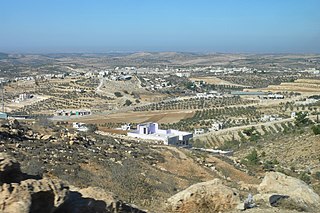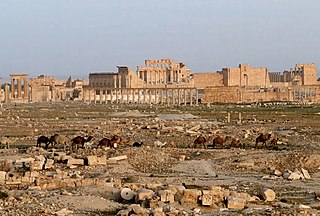Related Research Articles

Anubis, also known as Inpu, Inpw, Jnpw, or Anpu in Ancient Egyptian is the god of funerary rites, protector of graves, and guide to the underworld, in ancient Egyptian religion, usually depicted as a canine or a man with a canine head.

Religion in pre-Islamic Arabia included indigenous Arabian polytheism, ancient Semitic religions, Christianity, Judaism, Mandaeism, and Zoroastrianism.

Isis was a major goddess in ancient Egyptian religion whose worship spread throughout the Greco-Roman world. Isis was first mentioned in the Old Kingdom as one of the main characters of the Osiris myth, in which she resurrects her slain brother and husband, the divine king Osiris, and produces and protects his heir, Horus. She was believed to help the dead enter the afterlife as she had helped Osiris, and she was considered the divine mother of the pharaoh, who was likened to Horus. Her maternal aid was invoked in healing spells to benefit ordinary people. Originally, she played a limited role in royal rituals and temple rites, although she was more prominent in funerary practices and magical texts. She was usually portrayed in art as a human woman wearing a throne-like hieroglyph on her head. During the New Kingdom, as she took on traits that originally belonged to Hathor, the preeminent goddess of earlier times, Isis was portrayed wearing Hathor's headdress: a sun disk between the horns of a cow.

ʼĒl is a Northwest Semitic word meaning "god" or "deity", or referring to any one of multiple major ancient Near Eastern deities. A rarer form, 'ila, represents the predicate form in Old Akkadian and in Amorite. The word is derived from the Proto-Semitic *ʔil-, meaning "god".

Mount Hermon is a mountain cluster constituting the southern end of the Anti-Lebanon mountain range. Its summit straddles the border between Syria and Lebanon and, at 2,814 m (9,232 ft) above sea level, is the highest point in Syria. On the top, in the United Nations buffer zone between Syrian and Israeli-occupied territories, is the highest permanently manned UN position in the world, known as "Hermon Hotel", located at 2814 metres altitude. The southern slopes of Mount Hermon extend to the Israeli-occupied portion of the Golan Heights, where the Mount Hermon ski resort is located with a top elevation of 2,040 metres (6,690 ft). A peak in this area rising to 2,236 m (7,336 ft) is the highest elevation in Israeli-controlled territory.

Hellenization or Hellenism is the adoption of Greek culture, religion, language, and identity by non-Greeks. In the ancient period, colonization often led to the Hellenization of indigenous peoples; in the Hellenistic period, many of the territories which were conquered by Alexander the Great were Hellenized; under the Eastern Roman (Byzantine) Empire, much of its territory was Hellenized; and in modern times, Greek culture has prevailed over minority cultures in Modern Greece.

The Punic religion, Carthaginian religion, or Western Phoenician religion in the western Mediterranean was a direct continuation of the Phoenician variety of the polytheistic ancient Canaanite religion. However, significant local differences developed over the centuries following the foundation of Carthage and other Punic communities elsewhere in North Africa, southern Spain, Sardinia, western Sicily, and Malta from the ninth century BC onward. After the conquest of these regions by the Roman Republic in the third and second centuries BC, Punic religious practices continued, surviving until the fourth century AD in some cases. As with most cultures of the ancient Mediterranean, Punic religion suffused their society and there was no stark distinction between religious and secular spheres. Sources on Punic religion are poor. There are no surviving literary sources and Punic religion is primarily reconstructed from inscriptions and archaeological evidence. An important sacred space in Punic religion appears to have been the large open air sanctuaries known as tophets in modern scholarship, in which urns containing the cremated bones of infants and animals were buried. There is a long-running scholarly debate about whether child sacrifice occurred at these locations, as suggested by Greco-Roman and biblical sources.

Commagene was an ancient Greco-Iranian kingdom ruled by a Hellenized branch of the Iranian Orontid dynasty that had ruled over Armenia. The kingdom was located in and around the ancient city of Samosata, which served as its capital. The Iron Age name of Samosata, Kummuh, probably gives its name to Commagene.

The Temple of Eshmun is an ancient place of worship dedicated to Eshmun, the Phoenician god of healing. It is located near the Awali river, 2 kilometres (1.2 mi) northeast of Sidon in southwestern Lebanon. The site was occupied from the 7th century BC to the 8th century AD, suggesting an integrated relationship with the nearby city of Sidon. Although originally constructed by Sidonian king Eshmunazar II in the Achaemenid era to celebrate the city's recovered wealth and stature, the temple complex was greatly expanded by Bodashtart, Yatonmilk and later monarchs. Because the continued expansion spanned many centuries of alternating independence and foreign hegemony, the sanctuary features a wealth of different architectural and decorative styles and influences.

Khirbet el-Qom is an archaeological site in the village of al-Kum, West Bank, in the territory of the biblical Kingdom of Judah, between Lachish and Hebron, 14 km to the west of the latter.
Deir El Aachayer is a village north of Rashaya, in the Rashaya District and south of the Beqaa Governorate in Lebanon.

The Temples of Mount Hermon are around thirty Roman shrines and Roman temples that are dispersed around the slopes of Mount Hermon in Lebanon, Israel and Syria. A few temples are built on former buildings of the Phoenician & Hellenistic era, but nearly all are considered to be of Roman construction and were largely abandoned during the persecution of pagans in the late Roman Empire.
Bakka, Bekka or Beka is a village and municipality situated 85 kilometres (53 mi) east of Beirut in the Rashaya District of the Beqaa Governorate in Lebanon. The population of the village is Sunni.
Rakhlah, previously known as Zenopolis, is a village situated 31 kilometres (19 mi) west of Damascus, Syria. also known as "The town of Wine and Poetry".

Har Senaim or Senaim, is an archaeological site that sits on a peak near Mount Hermon in the Israeli-occupied portion of the Golan Heights, 15 kilometres (9.3 mi) north east of Kiryat Shmona and 4 kilometres (2.5 mi) from Banias.

Nabataean art is the art of the Nabataeans of North Arabia. They are known for finely-potted painted ceramics, which became dispersed among Greco-Roman world, as well as contributions to sculpture and Nabataean architecture. Nabataean art is most well known for the archaeological sites in Petra, specifically monuments such as Al Khazneh and Ad Deir.

The mysteries of Isis were religious initiation rites performed in the cult of the Egyptian goddess Isis in the Greco-Roman world. They were modeled on other mystery rites, particularly the Eleusinian mysteries in honor of the Greek goddesses Demeter and Persephone, and originated sometime between the third century BCE and the second century CE. Despite their mainly Hellenistic origins, the mysteries alluded to beliefs from ancient Egyptian religion, in which the worship of Isis arose, and may have incorporated aspects of Egyptian ritual. Although Isis was worshipped across the Greco-Roman world, the mystery rites are only known to have been practiced in a few regions. In areas where they were practiced, they served to strengthen devotees' commitment to the Isis cult, although they were not required to worship her exclusively, and devotees may have risen in the cult's hierarchy by undergoing initiation. The rites may also have been thought to guarantee that the initiate's soul, with the goddess's help, would continue after death into a blissful afterlife.

Palmyra is an ancient city in present-day Homs Governorate, Syria. Archaeological finds date back to the Neolithic period, and documents first mention the city in the early second millennium BC. Palmyra changed hands on a number of occasions between different empires before becoming a subject of the Roman Empire in the first century AD.

The Roman temple of Bziza is a well-preserved first century AD building dedicated to Azizos, a personification of the morning star in the Canaanite mythology. This Roman temple lends the modern Lebanese town of Bziza its current name as Bziza is a corruption of Beth Azizo meaning the house or temple of Azizos. Azizos is identified as Ares by Julian the Apostate.

Umm Al Amad, or Umm el 'Amed or al Auamid or el-Awamid, is an Hellenistic period archaeological site near the town of Naqoura in Lebanon. It was discovered by Europeans in the 1770s, and was excavated in 1861. It is one of the most excavated archaeological sites in the Phoenician heartland.
References
- ↑ Jalabert, L., "Inscriptions grecques et latines de Syrie (deuxième série)" in Mélanges de la Faculté Orientale de Beyrouth 2, p.265-320, 1907.
- ↑ Ted Kaizer (2008). The Variety of Local Religious Life in the Near East In the Hellenistic and Roman Periods. BRILL. pp. 89–. ISBN 978-90-04-16735-3 . Retrieved 18 September 2012.
- ↑ Brown, J., E. Meyers, R. Talbert, T. Elliott, S. Gillies (20 October 2012). "Places: 678253 (Kiboreia)". Pleiades. Retrieved September 18, 2012.
{{cite web}}: CS1 maint: multiple names: authors list (link) - ↑ Emile Puech (11 June 1998). Qumran Grotte 4: XVIII: Textes Hebreux (4Q521-4Q528, 4Q576-4Q579). Oxford University Press. pp. 52–. ISBN 978-0-19-826948-9 . Retrieved 18 September 2012.
- 1 2 Susanne Carlsson (29 April 2010). Hellenistic democracies: freedom, independence and political procedure in some east Greek city-states. Franz Steiner Verlag. ISBN 978-3-515-09265-4 . Retrieved 18 September 2012.
- ↑ Fergus Millar (1993). The Roman Near East, 31 B.C.-A.D. 337. Harvard University Press. pp. 311–. ISBN 978-0-674-77886-3 . Retrieved 18 September 2012.